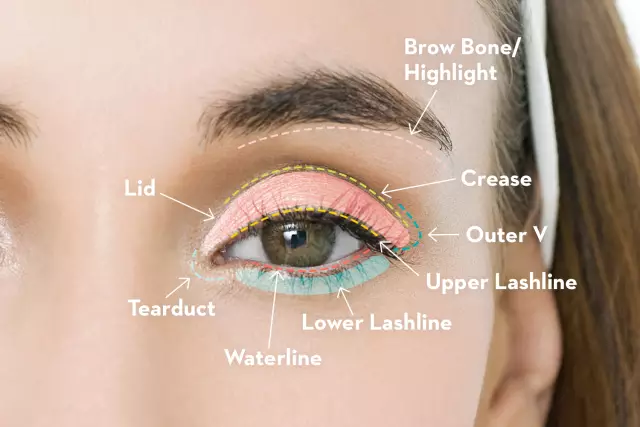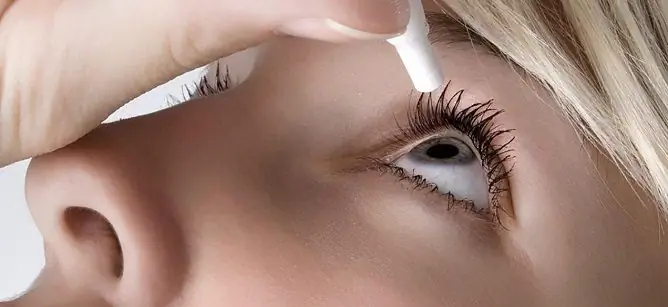- Author Rachel Wainwright [email protected].
- Public 2023-12-15 07:39.
- Last modified 2025-11-02 20:14.
Sigida crystal
Sigida crystal: instructions for use and reviews
- 1. Release form and composition
- 2. Pharmacological properties
- 3. Indications for use
- 4. Contraindications
- 5. Method of application and dosage
- 6. Side effects
- 7. Overdose
- 8. Special instructions
- 9. Application during pregnancy and lactation
- 10. Use in childhood
- 11. Drug interactions
- 12. Analogs
- 13. Terms and conditions of storage
- 14. Terms of dispensing from pharmacies
- 15. Reviews
- 16. Price in pharmacies
Latin name: Sigida crystall
ATX code: S01GA51
Active ingredient: naphazoline (Naphazoline)
Manufacturer: Solopharm (Russia)
Description and photo update: 2018-27-11
Prices in pharmacies: from 185 rubles.
Buy

Sigida crystal is an alpha-adrenergic agonist, decongestant drug.
Release form and composition
The drug is available in the form of eye drops 0.05%: clear liquid, colorless or yellowish (0.4 ml each in polyethylene dropper tubes: 5 dropper tubes in a package, in a cardboard box 2, 4 or 6 packages; 10 tube-droppers in a package, in a cardboard box 1, 2 or 3 packages and instructions for use Sigida crystal).
1 ml of drops contains:
- active substance: naphazoline nitrate (naphthyzine) - 0.5 mg;
- auxiliary components: disodium edetate dihydrate (Trilon B), boric acid, sodium hyaluronate, macrogol 300, sodium hydroxide solution 1 M or nitric acid solution 0.1 M, water for injection.
Pharmacological properties
Pharmacodynamics
Sigida crystal is an alpha-adrenergic agonist, a drug for topical use in ophthalmology. The mechanism of its action is due to the property of the active substance - naphazoline, to stimulate the alpha 2 -adrenergic receptors of the vessels and to have a vasoconstrictor effect. That helps to reduce hyperemia and edema of the conjunctiva.
Pharmacokinetics
After the introduction of naphazoline into the conjunctival sac, the therapeutic effect occurs quickly. The vasoconstrictor effect on the mucous membranes of the eye lasts from 6 to 8 hours.
The absorption of naphazoline into the systemic circulation is possible, more often it occurs in the treatment of children and elderly patients.
Indications for use
The use of Sigida crystal drops is indicated as a symptomatic therapy for the temporary relief of secondary redness (redness) of the eyes caused by moderate irritation and allergic conjunctivitis.
It is advisable to use the drug only with mild eye irritation.
Contraindications
Absolute:
- angle-closure glaucoma;
- age up to two years;
- hypersensitivity to drug components.
Sigida crystal eye drops should be used with caution in glaucoma, dry keratoconjunctivitis, severe cardiovascular diseases (including ischemic heart disease, arterial hypertension), prostatic hyperplasia, pheochromocytoma, diabetes mellitus, hyperthyroidism, porphyria, dry rhinitis, concomitant therapy with oxidase inhibitors or monotherapy drugs that cause an increase in blood pressure (BP), as well as during pregnancy and breastfeeding.
Sigida crystal, instructions for use: method and dosage
Sigida crystal eye drops are intended for topical application, by introduction into the conjunctival sac.
To carry out the procedure, take the dropper tube in your hand and, holding it in an upright position, turn and separate the valve. After instilling the required amount of the drug into the conjunctival sac of the eyes, carefully close (without blinking) for a few minutes so that the drug is completely absorbed into the mucous membrane. To prevent drops from entering the nasal cavity through the nasolacrimal canal, it is necessary to press with the bend of the finger on the inner corner of the closed eyelid.
Do not touch the tip of the dropper to the eye and other surfaces in order to prevent infection of its contents.
The procedure is carried out in compliance with the rules of antiseptics.
The amount of the drug in the dropper tube is sufficient for one instillation procedure in both eyes. The remains of the drug and the tube after drug administration should be disposed of.
Recommended dosage:
- children 2-6 years old: 1 drop 1-2 times a day;
- children and adolescents over 6 years old, adult patients: 1-2 drops 2-3 times a day.
The duration of the course of treatment is 3-5 days.
If, after two days of using the Sigida crystal, the condition does not improve or the symptoms of irritation or hyperemia worsen, there is pain in the eye, visual impairment, you should immediately stop the procedure and consult a doctor.
Side effects
- on the part of the organ of vision: burning, pain in the eye area, itching, reactive hyperemia of the conjunctiva, mydriasis, dryness of the nasal mucosa, increased intraocular pressure, visual impairment;
- systemic side effects (mainly in children and the elderly): possibly - pallor of the skin, increased sweating, nausea, drowsiness, headache, agitation, dizziness, trembling, tachycardia, increased blood pressure, pain in the heart.
Overdose
When applied topically, an overdose of the drug is unlikely. In case of accidental ingestion of drops, such undesirable phenomena of a systemic nature as sweating, hypothermia, depression of the central nervous system, drowsiness, heart rhythm disturbances, prolonged mydriasis, increased blood pressure and its subsequent sharp decrease, tachycardia, coma may occur.
Treatment is recommended symptomatic.
special instructions
Against the background of the use of Sigid crystal, the development of mydriasis is possible.
Before using the drug, it is recommended to consult a doctor, especially when treating children and the elderly.
If, upon visual inspection of the solution, it is found to be cloudy or discolored, then the tube with drops should be disposed of.
Direct contact of eye drops with contact lenses should not be allowed, therefore, it is recommended to remove contact lenses before each procedure and put them back on the cornea after 15 minutes.
In case of ischemic heart disease, arterial hypertension and other severe cardiovascular diseases, pheochromocytoma, metabolic disorders (diabetes mellitus, hyperthyroidism), concomitant therapy with monoamine oxidase inhibitors and other drugs that can increase blood pressure, before using Sigid crystal, patients should compare the expected benefit and potential risk from therapy.
Violation of the recommended dosage regimen may cause redness of the eyes.
If irritation or redness of the eyes is caused by such serious diseases of the organ of vision as chemical trauma to the cornea, infections, a foreign body, then you should consult a doctor.
An immediate visit to a doctor is required if intense pain in the eyes, redness of the eyes, sudden appearance of floating spots in front of the eyes, headache, rapid loss of vision, pain or double vision in the eyes in bright light appears against the background of the use of Sigid crystal.
With epidermal-endothelial corneal dystrophy (Fuchs dystrophy), eye drops should not be used.
Influence on the ability to drive vehicles and complex mechanisms
Immediately after the introduction of drops, a temporary visual impairment is possible; during this period, driving and performing other potentially hazardous activities should be avoided.
Application during pregnancy and lactation
During gestation and lactation, Sigida crystal should be used with caution and only in cases where the expected therapeutic effect for the mother is higher than the possible risk for the fetus and child.
Pediatric use
The use of Sigida crystal is contraindicated for the treatment of children under the age of two years.
The use of drops in children aged 2 to 6 years should be carried out only under the supervision of a doctor.
Recommended dosage:
- children aged 2 to 6 years: 1 drop 1-2 times a day;
- children over 6 years old: 1-2 drops 2-3 times a day.
The duration of the course of treatment is no more than 5 days.
Drug interactions
With the simultaneous use of Sigid crystal with tricyclic antidepressants, it is possible to increase the vasoconstrictor effect of naphthyzine.
It should be borne in mind that when combined with monoamine oxidase inhibitors or when using the drug during the first 14 days after their withdrawal, there is a risk of developing a hypertensive crisis.
With concomitant therapy with other local ophthalmic agents, it is recommended to observe an interval between procedures of 15 minutes.
Analogs
Analogs of Sigid crystal are Sanorin, Sanorin with eucalyptus oil, Naphtizin, Naphtizin plus, Adrianol, Galazolin, etc.
Terms and conditions of storage
Keep out of the reach of children.
Store at temperatures up to 25 ° C.
The shelf life is 3 years.
Terms of dispensing from pharmacies
Available without a prescription.
Reviews for Sigida crystal
Reviews about Sigida crystal are positive. In them, patients report that the use of drops allows you to get rid of reddening of the eyes with allergic conjunctivitis, dryness and irritation of the eyes from prolonged exposure to a computer monitor. The advantages of the drug include high efficiency at a relatively low cost, ease of use, lack of discomfort.
Price for Sigida crystal in pharmacies
The price of Sigida crystal for a package containing 10 tubes of 0.4 ml droppers can range from 253 rubles.
Sigida crystal: prices in online pharmacies
|
Drug name Price Pharmacy |
|
Sigida crystal 0.05% eye drops without preservatives 0.4 ml 10 pcs. RUB 185 Buy |
|
Sigida Crystal eye drops 0.05% 10ml 327 r Buy |

Maria Kulkes Medical journalist About the author
Education: First Moscow State Medical University named after I. M. Sechenov, specialty "General Medicine".
Information about the drug is generalized, provided for informational purposes only and does not replace the official instructions. Self-medication is hazardous to health!






